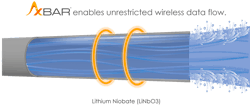The Importance of RF Filters in Advanced Wireless Systems
This article appeared in Evaluation Engineering and has been published here with permission.
The explosion in growth of cloud-enabled IoT-focused products and solutions is causing even more traffic in our already crowded airwaves. If the radio spectrum could be thought of as a highway, and the bands as lanes in it, RF filters keep the signal "between the lines" so that data moves with minimal collisions or interference. RF filters are among the key core technologies to address next-generation systems that need high RF performance, such as autonomous vehicles, telemedicine, smart facilities, and other highly connected apps.
One of the companies operating in the space, Resonant, recently released a new RF filter, designed with the company's proprietary XBAR technology. We talked to Mike Eddy, the VP of Corporate Development at Resonant, to get a better idea on how the company's advanced RF filter technology can enable next-generation wireless products and solutions.
EE: Hi Mike, welcome back! I understand Resonant recently held a "Breaking Through the Noise of 5G in Europe" Webinar Series. Considering all of the pressures on wireless developers, ensuring optimal wireless performance has to be paramount. What are some of your impressions from the event series?
Mike Eddy: Thanks for having me. The Webinar Series featured industry experts who discussed the evolution to 5G, some of the drivers of 5G adoption, the continued role of 4G, next-generation Wi-Fi, with particular emphasis on the status of 5G in Europe. What I got was that Europe is moving much more aggressively now on the first key piece of any new wireless technology, which is allocating spectrum. So you see over the first half of 2021, several countries, both in the EU and the UK, are actually auctioning off spectrum in the key bands, and particularly the mid-band, 3.4 GHz to 3.8 GHz.
Europe did a really, really good job of realizing that they needed to—what they call harmonize bands to 5G. What they did is they said, "Okay, we're going to call these the pioneer 5G bands and come up with a strategy where you can get full coverage. You can get high-speed data wirelessly and localized you can get extremely high speed." And that's related to the different frequency bands. So they knew that 700 MHz, 3.4 to 3.8 GHz, and millimeter-wave 26-GHz bands, as a strategy to really take advantage of 5G.
So what you're seeing right now in Europe is they are particularly sensitive to the situation with Huawei. Most of the 4G infrastructure in Europe is Huawei. 5G and the initial rollout needs to work with 4G, and therefore many countries are trying to decide what to do about whether they're going to have a new contract with Huawei, or whether they're going to take a different tack and use some of the other major players. So Europe was kind of behind China and the US, but now, after COVID, seems to be easing a little bit, there seems to be a real aggressive push now to roll out 5G in Europe. And as you said, what that means for everybody is crowded airwaves.
EE: How much has this issue with Huawei been a technical issue, and how much of it is a political issue? Recognizing that we're not going to go deeply into political, I just wanted to nod in that direction and recognize that this is bigger than just engineering.
Eddy: Absolutely. It is more political than technical. Obviously there are issues around the security of these major infrastructures, but a lot of it is political and there is pressure in Europe to move away from Huawei infrastructure. There are not a lot of options now, but will increase as we move to what's called an Open RAN, a more open architecture.
EE: This would almost be a perfect storm for a peer-to-peer architecture to suddenly materialize. I can remember in the early days of the web, where there were companies who were trying to develop a peer-to-peer architecture that would run concurrently with, or under the layer of, the internet and the grid that we know of, with just unit-to-unit comms. In other words, creating a mesh network through the IoT devices themselves.
Eddy: That's a great point. So, the need for low latency in 5G is dramatically changing the architecture for infrastructure. So, the cloud and compute needs to go closer to the user to improve latency, which means then that that architecture has to change. And that opens up the opportunity for a different kind of network. Although it's difficult to see how you can not use some of the major players, there is a move by the major operators to try and use a much more distributed and open architecture, which is what's called Open RAN.
The newer players are much more open to using this new architecture. For example Dish, which is kind of a new fourth operator, has decided to use this Open RAN architecture. One thing when you're talking about a more distributed architecture and compute and cloud close to the user, it means you have to partner with some of the major hyperscalers who are much more used to cloud computing. There are a lot of partnerships being announced, Amazon's AWS, Microsoft's Azure. They're all working with the major operators to help them change that architecture to a much more open and distributed architecture.
EE: It only benefits everybody, right?
Eddy: Correct. It ultimately will mean the experience is much better for the consumer. And ultimately it'll mean that it's a much lower cost to grow a network.
EE: Now, having said all of that, that brings back into focus the issue of the crowded bandwidth, and staying in your lane, and making sure everything is done precisely. What are your thoughts on that?
Eddy: We talked how the airwaves are getting more and more crowded and you need to keep your signals in the correct lanes in order to take full advantage of these frequency bands. Whether that's 5G, whether that's the new Wi-Fi bands, for instance at 6 GHz, which are being allocated now both in the U.S., Canada, Brazil, and in Europe, and also ultra wideband, which is being used now in phones above the 6-GHz band.
All of these bands are being used, and you need to make sure that they're kept very clearly separate so that there's no interference. Each frequency band needs to be in the correct lane, and that's where filters become critical. That's why, as you see in the latest iPhone 12, about 100 filters in an iPhone 12 in order to make sure that you get the best possible signal, which relates to the best possible consumer experience from 5G, from Wi-Fi, for most wideband in high data rates, very clear streaming video.
EE: Now, Mike, that brings to mind two issues. One is lean management and the other is the physical footprint of the solution. Are these all discrete filters or are they filter arrays? Because at some point you're still soldering a lot of little teeny things to the board.
Eddy: Yes, exactly. That's why, because of this complexity, there is a very, very distinct move away from discrete filters to modules, so that the phone OEMs can buy an already pre-tested module that has all of those lanes very clearly defined within the module, which you can attach to the main PC board of a phone. With these modules, because of the nature of all these different frequency bands, it makes sense to break them up into big blocks.
You'd need a low-band module, which covers 600 MHz to about 1.2 GHz, a mid-band module, which covers that 2-GHz range, then a high-band module to cover 2 to 3 GHz. However, with all these new bands, there's going to be an ultra-high-band module, which covers what's called the sub-6-GHz range for 5G, millimeter-wave modules, which covers the 24- to 30-GHz range. So, breaking it down into building blocks makes sense, so you don't have to put an individual discrete filter on a PC board and test it and put another one on it, test it, because it becomes just an unmanageable complexity by doing it that way. So getting a pre-tested module makes a lot of sense.
EE: When you're talking about the RF pathway, there are so many choke points in so many areas. If the antenna isn't properly matched, you're going to lose a lot of power and you're going to lose a lot of performance. So it's not just that you have to have everything, it also has to be optimally matched to ensure the minimum loss.
Eddy: I'll give you two key points there. One is you could just keep adding antennas, but that becomes unmanageable very quickly. So what's happening is there is a big drive now and a need for sharing antennas. As I mentioned, if you've got a Wi-Fi module and a 5G module, they could share the same antenna by using what's called a multiplexer at the antenna. Right now, the latest iPhone 12 has eight antennas, for instance, using antenna sharing, but then you also have to be very clear.
You say, "How can I have the lowest loss possible?" Which means you need very good filters, with very steep skirts to prevent interference and degradation of your main signal. That's where our new XBAR filter technology comes into play, where you need these very wide bandwidths, at these high frequencies that have a minimal loss so that you receive signals as pure as possible. And you send signals with your amplifier as close as possible without draining your battery. Because what happens is if you add the loss on the signal, your power has to crank up, which drains your battery faster. And so, this idea that you brought up, a very, very low loss to main signal integrity, is critical. And that's where filters play an absolutely pivotal role.
EE: Do you have an end thought to round this all out and tie it with a new bow?
Eddy: We talked about how we're in the very early stages of these new wireless technologies. So 5G is in the first couple of years, what you see in the next two to three years is the spectrum will be allocated, then you have to deploy your infrastructure, so you're really going to start seeing the true benefits of 5G, of ultra wideband in the next two to three years. That's when you're going to see the consumer experience really take off, and you'll start seeing all these new, very, very exciting applications, both in the smartphone, in devices, in IoT devices, in drones, you're just opening up a whole wealth of new applications.
It's critical, as I said, that we're going to need very, very high-performance wide-bandwidth low-loss filters. The next two to three years are going to be a really exciting time for wireless technologies and the new applications that 5G is going to generate.
About the Author
Alix Paultre
Editor-at-Large, Microwaves & RF
Alix is Editor-at-Large for Microwaves & RF.
An Army veteran, Alix Paultre was a signals intelligence soldier on the East/West German border in the early ‘80s, and eventually wound up helping launch and run a publication on consumer electronics for the U.S. military stationed in Europe. Alix first began in this industry in 1998 at Electronic Products magazine, and since then has worked for a variety of publications, most recently as Editor-in-Chief of Power Systems Design.
Alix currently lives in Wiesbaden, Germany.



